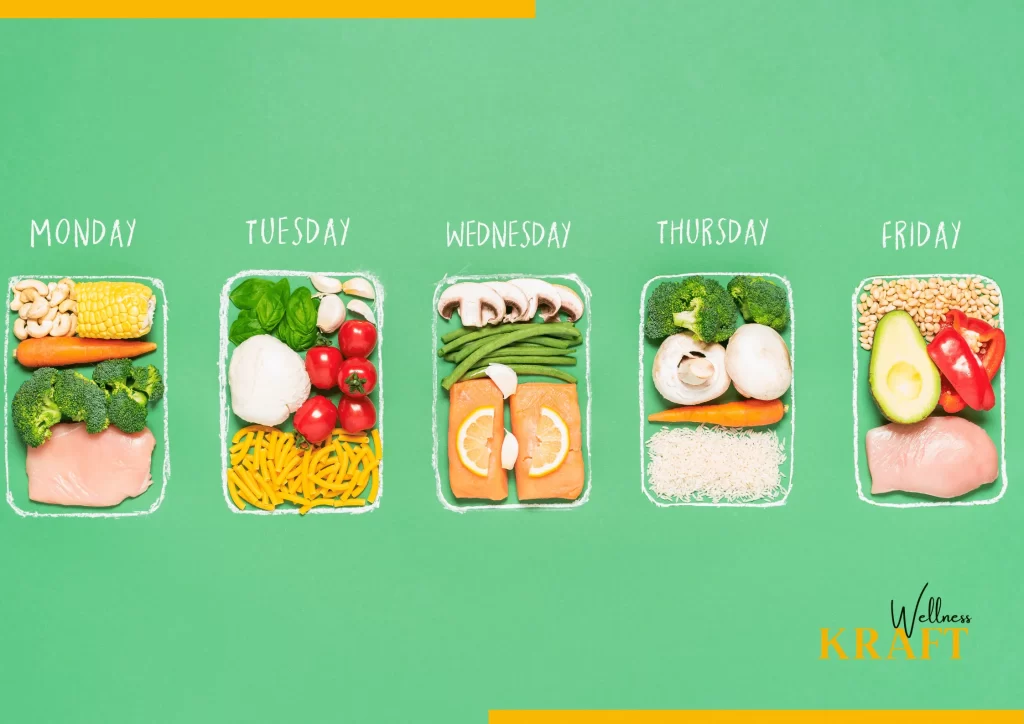“Building muscle is not just about lifting weights, it’s about challenging yourself, pushing your limits, and discovering your potential.” – Wellness Kraft
Introduction
Many fitness followers share the objective of building muscle. It not only improves our physical appearance, but it also brings numerous health benefits, such as increased strength, improved bone density, and a better metabolic rate. However, building muscle is not an easy task and requires a lot of dedication and effort.
In this guide, we have compiled the best tips and strategies from fitness experts to help you achieve your muscle-building goals. We will cover the most important aspects of muscle building, including nutrition, resistance training, cardiovascular exercise, rest and recovery, and supplements. Additionally, we will discuss common mistakes that people make when trying to build muscle and how to avoid them.
Whether you’re a beginner or an experienced lifter, this guide will provide you with the knowledge and tools you need to maximize your muscle-building potential. Let’s get started!
Table of Contents
Nutrition for Muscle Building

Nutrition is a critical component of building muscle. In order to build muscle, you need to provide your body with the right nutrients and fuel to support muscle growth and repair. Here are some key nutrition tips to keep in mind when building muscle:
Eat Enough Calories:
To build muscle, you need to be in a calorie surplus, which means you need to consume more calories than you burn. This will provide your body with the extra energy it needs to build muscle. However, it’s important to make sure you’re not consuming too many calories, as this can lead to unwanted fat gain. Aim for a daily calorie surplus of 250 to 500 calories.
Consume Sufficient Protein:
Protein is essential for building muscle, as it provides the building blocks (amino acids) your body needs to repair and grow muscle tissue. Aim for at least 1 gram of protein per pound of body weight per day, and consume protein sources that are high in quality, such as lean meats, fish, eggs, dairy, and plant-based sources like beans and nuts.
Don’t Neglect Carbohydrates:
Carbohydrates provide your body with the energy it needs to fuel your workouts and support muscle growth. Aim to consume complex carbohydrates like whole grains, fruits, and vegetables, and avoid processed or refined carbohydrates.
Include Healthy Fats:
Fats are important for hormone production, joint health, and overall health. Include healthy fats in your diet, such as avocados, nuts, seeds, and olive oil.
Stay Hydrated:
Drinking enough water is essential for muscle growth and repair. Aim to drink at least 8-10 glasses of water per day, and more if you’re sweating heavily during workouts.
By following these nutrition tips, you can fuel your body properly for muscle building and optimize your results.
Macro and Micronutrient Requirements for Muscle Building

In addition to the general nutrition tips mentioned above, it’s important to understand the specific macro and micronutrient requirements for muscle building.
Macronutrients:
Protein:
As mentioned earlier, protein is essential for building and repairing muscle tissue. Aim for between 1 and 1.5 grams of protein per pound of body weight per day.
Carbohydrates:
Carbohydrates provide your body with energy for workouts and support muscle growth. Aim for two to three grams of carbohydrates per pound of body weight daily.
Fat:
Fat is important for hormone production and overall health. Aim for between 0.5 and 1 gram of fat per pound of body weight daily.
Micronutrients:
Calcium:
Calcium is essential for muscle contraction and bone health. Aim for 1,000-1,200 milligrams of calcium per day.
Iron:
Iron is important for oxygen transport and energy production. Aim for 18 milligrams of iron per day for women and 8 milligrams per day for men.
Vitamin D:
Vitamin D is essential for calcium absorption and muscle function. Aim for 600-800 IU of vitamin D per day.
Foods to Eat and Avoid

When building muscle, it’s important to choose nutrient-dense foods that provide your body with the right balance of macro and micronutrients. Include the following ingredients in your diet:
Lean protein sources: Chicken, turkey, fish, lean beef, tofu, tempeh, legumes
Complex carbohydrates: Whole grains, fruits, vegetables, sweet potatoes, quinoa, brown rice
Healthy fats: Avocado, nuts, seeds, olive oil, and coconut oil .
Calcium-rich foods: Dairy, leafy greens, fortified cereals, canned fish with bones
Iron-rich foods: Red meat, poultry, fish, beans, lentils, fortified cereals
Vitamin D-rich foods: Fatty fish, egg yolks, fortified foods
On the other hand, here are some foods to limit or avoid:
Processed foods: Chips, candy, fast food, sugary drinks
Trans fats: Fried foods, baked goods, processed snacks
Excessive alcohol: Alcohol can impair muscle recovery and increase inflammation, so limit your intake to moderate levels.
Sample Meal Plan for Muscle Building

Here’s a sample meal plan for a day of muscle building:
Breakfast: Oatmeal with almond milk, berries, and nuts
Snack: Greek yogurt with sliced banana and honey
Lunch: Grilled chicken breast, sweet potato, and steamed broccoli
Snack: Apple with almond butter
Dinner: Baked salmon, quinoa, and roasted vegetables
Snack: Cottage cheese with mixed berries
By following a balanced meal plan that provides the right combination of macro and micronutrients, you can fuel your body for muscle building and optimize your results.
Resistance Training in Muscle Building

Resistance training is essential for building muscle. When you lift weights or perform other resistance exercises, you create small tears in your muscle fibers. As your body repairs these tears, it builds new muscle tissue, resulting in larger and stronger muscles.
Types of Resistance Training
There are many types of resistance training, including:
Weightlifting: This includes exercises like bench press, squats, deadlifts, and curls, using weights such as dumbbells, barbells, or weight machines.
Bodyweight exercises: These exercises use your own bodyweight as resistance, such as push-ups, pull-ups, squats, and lunges.
Resistance bands: These stretchy bands provide resistance and can be used for a variety of exercises.
Suspension training: This type of training uses straps suspended from a ceiling or wall to create resistance for exercises like rows, push-ups, and squats.
Principles of Progressive Overload

Progressive overload is the principle of gradually increasing the weight or resistance in your workouts over time. This helps to continually challenge your muscles and promote growth. Here are some ways to implement progressive overload in your workouts:
Increase weight: Gradually increase the weight you’re lifting for each exercise.
Increase reps: If you’re not ready to increase weight yet, try increasing the number of reps you do for each exercise.
Decrease rest time: Decreasing the amount of rest time between sets can increase the challenge of your workout.
Change exercises: Switching up the exercises you do can help prevent plateaus and keep your muscles guessing.
Sample of a Resistance Training Plan
Here’s an example of a resistance training program for muscle building:
Day 1:
-Back squat with a barbell: 3 sets of 8 reps
-Bench press with a barbell: 3 sets of 8 reps
-Dumbbell bent over row: 3 sets of 8 reps
-Bicep curl with Barbell : 3 sets of 10 reps
-Plank: 3 sets of 30 seconds
Day 2:
-Deadlift: 3 sets of 8 reps
-Dumbbell shoulder press: 3 sets of 10 reps
-Lat pulldown: 3 sets of Ten reps
-Tricep pushdown: 3 sets of 12 reps
-Russian twist: 3 sets of 20 reps
Day 3:
-Front squat with a barbell: 3 sets of 8 repetitions
-Incline dumbbell press: three sets of ten repetitions
-Seated cable row: three sets of ten repetitions
-Hammer curls: three sets of 12 repetitions
-Bicycle crunch: 3 sets of 20 reps
Be sure to warm up before each workout and cool down and stretch afterward. This program can be adjusted based on your individual goals and fitness level, but it provides a good starting point for a resistance training program aimed at muscle building.
Cardiovascular Exercise in Muscle Building

Cardiovascular exercise, also known as cardio, is essential for developing muscle because it helps increase your endurance and overall fitness level.
Cardio also helps with recovery between resistance training sessions, and can help you burn excess body fat, which can help you achieve a more toned and defined appearance.
Types of Cardiovascular Exercise
There are many different types of cardio exercises you can do to support your muscle building goals, including:
Running or jogging: This is a classic form of cardio that can be done outside or on a treadmill.
Cycling: This can be done on a stationary bike or outdoors on a road bike.
Swimming: Swimming is a great low-impact form of cardio that can be easier on your joints.
High-intensity interval training (HIIT): This involves alternating periods of high-intensity exercise with periods of rest or lower-intensity exercise.
Rowing: Rowing is a full-body workout that can be done on a machine or on the water.
How Much Cardiovascular Exercise to Do for Muscle Building ?
The amount of cardio you should do for muscle building will depend on your goals, fitness level, and overall workout routine. Generally, it’s recommended to do at least 150 minutes of moderate-intensity cardio per week, or 75 minutes of high-intensity cardio per week. This can be broken down into 30-minute sessions, five days per week for moderate-intensity cardio, or 25-minute sessions, three days per week for high-intensity cardio.
It’s important to balance your cardio workouts with your resistance training workouts, as too much cardio can interfere with muscle building. Aim to incorporate cardio into your routine 2-3 times per week, and adjust the intensity and duration as needed based on your individual needs and goals.
Rest and Recovery in Muscle Building

Rest and recovery are crucial for muscle building because they give your muscles time to repair and grow stronger after a workout. Without adequate rest and recovery, your muscles can become overworked and fatigued, which can lead to injury and hinder muscle growth. Additionally, rest and recovery help to restore your energy levels and reduce the risk of burnout or overtraining.
How Much Rest is Needed for Muscle Building ?
The amount of rest needed for muscle building will depend on various factors, including your age, fitness level, and the intensity of your workouts. Generally, it’s recommended to give your muscles 24-48 hours of rest between workouts that target the same muscle groups. For example, if you do a heavy leg day on Monday, you may want to focus on upper body exercises on Tuesday and Wednesday before returning to leg exercises on Thursday. Additionally, getting enough sleep is important for muscle recovery, and most adults require 7-9 hours of sleep per night.
Techniques for Optimising Recovery

There are several strategies you can use to optimize your rest and recovery for muscle building, including:
Get enough sleep: As mentioned, getting enough sleep is crucial for muscle recovery and overall health. Aim to get 7-9 hours of sleep per night, and try to establish a consistent sleep schedule.
Stretching: Stretching can help improve flexibility and range of motion, and can also aid in muscle recovery. Incorporate dynamic stretching before your workout, and static stretching after your workout or on rest days.
Foam rolling: Foam rolling can help release tension in your muscles and improve circulation, which can aid in muscle recovery. Try incorporating foam rolling into your post-workout routine or on rest days.
Active recovery: Light exercise, such as walking or cycling, can help promote circulation and aid in muscle recovery. Try incorporating active recovery on rest days, or in between heavy lifting sessions.
Proper nutrition: Proper nutrition, including adequate protein and hydration, can also aid in muscle recovery. Aim to eat a balanced diet with plenty of lean protein, fruits, and vegetables, and stay hydrated throughout the day.
Supplements for Muscle Building

Supplements are products that are taken orally and contain one or more ingredients that are intended to supplement the diet. There are many different types of supplements available on the market, including those that are marketed for muscle building. Some of the most commonly used supplements for muscle building include:
Protein powder: Protein powder is a supplement that contains high levels of protein and is often used to supplement the diet of those who are looking to build muscle.
Creatine: Creatine is a supplement that is believed to help increase muscle mass and strength by increasing the amount of energy available to the muscles during exercise.
BCAAs: Branched-chain amino acids (BCAAs) are a type of amino acid that are believed to help improve muscle growth and recovery.
Beta-alanine: Beta-alanine is an amino acid that is believed to help improve endurance and performance during exercise.
Which Supplements are Backed by Research ?
While there is some evidence to support the use of certain supplements for muscle building, it’s important to note that supplements are not a substitute for a healthy diet and exercise program. Some supplements that are backed by research for muscle building include:
Protein powder: Studies have shown that protein powder can help improve muscle growth and recovery when consumed as part of a balanced diet and exercise program.
Creatine: Creatine has been extensively studied and has been shown to help increase muscle mass and strength when consumed as part of a balanced diet and exercise program.
BCAAs: Some studies have suggested that BCAAs may help improve muscle growth and recovery, particularly when consumed before and after exercise.
Beta-alanine: Beta-alanine has been shown to help improve endurance and performance during high-intensity exercise, such as weightlifting and sprinting.
Safety Considerations When Taking Supplements:
While some supplements may be helpful for muscle building, it’s important to use caution when taking them. Some supplements can have negative side effects or interact with other medications, and some may not be safe for certain populations, such as pregnant women or individuals with certain medical conditions. Additionally, the quality and purity of supplements can vary, so it’s important to do your research and purchase supplements from reputable sources. It’s always a good idea to talk to your healthcare provider before starting any new supplement regimen.
Overview of Common Mistakes to Avoid

When trying to build muscle, there are a number of common mistakes that people often make. Some of these mistakes are:
Not eating enough:
Building muscle requires fuel, and if you’re not eating enough calories, you may not be providing your body with the nutrients it needs to build muscle.
Doing too much cardio:
While cardiovascular exercise can be beneficial for overall health and fitness, doing too much cardio can interfere with muscle growth.
Neglecting rest and recovery:
Building muscle requires not only exercise, but also rest and recovery. Neglecting these important components of muscle building can lead to burnout and injury.
Not using proper form:
Using improper form during resistance training can increase the risk of injury and reduce the effectiveness of the exercise.
Not varying your routine:
Doing the same exercises over and over again can lead to a plateau in muscle growth. It’s important to vary your routine to keep your muscles challenged.
How to Avoid These Mistakes ?
To avoid these common mistakes when trying to build muscle, it’s important to:
1.Eat a balanced diet that includes enough calories and protein to support muscle growth.
2.Incorporate cardiovascular exercise in moderation, focusing on high-intensity interval training (HIIT) rather than long, steady-state cardio sessions.
3.Prioritize rest and recovery by getting enough sleep, taking rest days, and incorporating stretching and foam rolling into your routine.
4.Focus on using proper form during resistance training, and consider working with a trainer or coach if you’re not sure how to perform an exercise correctly.
5.Vary your routine by changing up exercises, sets, and reps, and incorporating new forms of resistance training such as bodyweight exercises or using resistance bands.
Concluding Thoughts
In conclusion, building muscle requires a combination of proper nutrition, resistance training, cardiovascular exercise, rest and recovery, and potentially the use of supplements. The tips and strategies outlined in this guide can help you optimize your muscle-building efforts and achieve your fitness goals.
If you’re interested in learning more about health and wellness, Wellness Kraft has a wealth of articles and resources on topics such as nutrition, exercise, mental health, and more. With the right information and support, you can make positive changes to your lifestyle and improve your overall health and well-being. Remember to always prioritize safety and proper form in your exercise routine, and to listen to your body and adjust your routine as needed.
Key Takeaways
1.Proper nutrition is essential for building muscle, including consuming enough calories and protein.
2.Resistance training is the most effective way to build muscle, with a focus on progressive overload and proper form.
3.Cardiovascular exercise can support muscle building, but it should be done in moderation.
4.Rest and recovery are crucial for muscle building and injury prevention.
5.Supplements can potentially support muscle building, but it’s important to do your research and prioritize safety.
6.Avoid common mistakes such as not eating enough, neglecting rest and recovery, and not varying your routine.
FAQs
1.For muscular growth, how much protein do I need?
Generally, it’s recommended to consume 1 gram of protein per pound of body weight per day for muscle building.
2.Should I prioritize completing more reps or lifting heavier weights?
Both lifting heavy weights and doing more reps can be effective for building muscle. It’s important to incorporate both into your routine and focus on progressive overload.
3.How often should I do resistance training?
It’s recommended to do resistance training 2-3 times per week, with at least one day of rest in between sessions.
4.Can I get stronger without using supplements?
Yes, you can gain muscle without using pills. Proper nutrition and exercise are the most important factors for muscle building.
5.How much cardiovascular exercise should I do for muscle building?
It’s recommended to do 2-3 sessions of cardiovascular exercise per week, for 20-30 minutes each session.
6.How much time does it take to build muscle?
The timeline for building muscle varies depending on factors such as genetics, nutrition, and exercise routine. Generally, it can take several months to see significant muscle growth.
7.Should I stretch before or after exercise?
It’s recommended to do dynamic stretching before exercise to warm up your muscles, and static stretching after exercise to cool down and improve flexibility.
8.How much rest do I need for muscle building?
It’s recommended to get 7-9 hours of sleep per night and to take at least one rest day per week to optimize rest and recovery for muscle building.
9.Can I build muscle at home without equipment?
Yes, bodyweight exercises such as push-ups, squats, and lunges can be effective for building muscle at home.
10.How can I track my progress in muscle building?
Keeping a record of your exercise routine, taking progress photos, and tracking your weight and body measurements can help you monitor your progress in muscle building.










